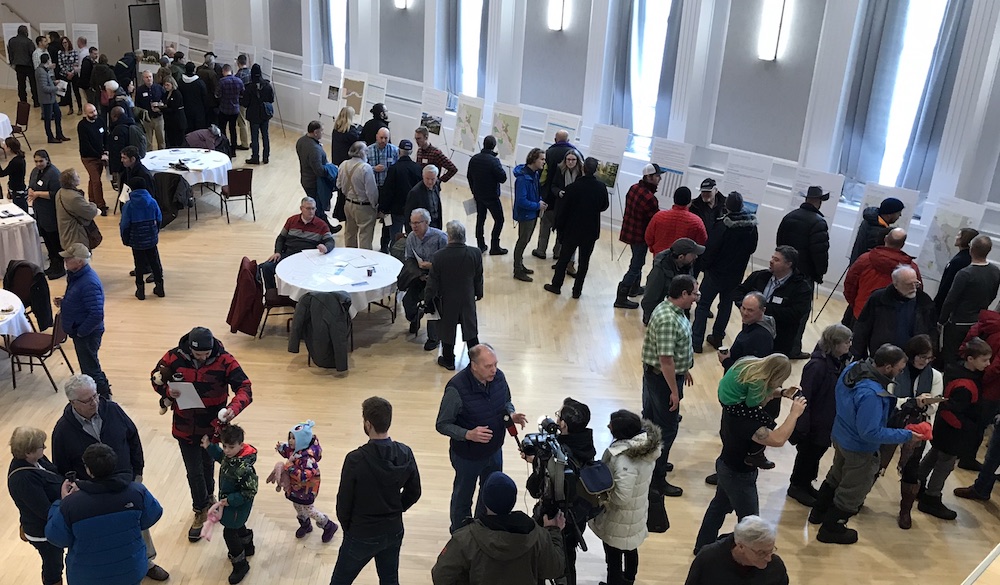I can’t tell you about the one in Drayton Valley on Friday, but everything seemed copacetic at the Bighorn Wildland Provincial Park proposal open house in Edmonton on Saturday afternoon.
But what would you expect? As is the case in most of Alberta, one suspects, support is pretty strong in Alberta’s Capital Region for the Kananaskis-Country-style approach proposed by the NDP government for managing the eastern slopes of the Rocky Mountains between the Kananaskis region and Banff National Park in the south and Jasper National Park in the north.
All the trouble that caused the province to temporarily back away from public information sessions on the proposal seemed to take place in smaller central Alberta centres in or near United Conservative Party Jason Nixon’s Rimbey-Rocky Mountain House-Sundre riding, where a cadre of all-terrain-vehicle operators determined there must be no limits on their destructive hobby was accused of trying to silence anyone who disagreed with them and bully public servants at the initial public events.
When Environment Minister Shannon Phillips decided to suspend the public information sessions in January and rely on on-line consultations instead, the Opposition UCP loudly accused the government of trying to suppress widespread popular opposition to the plan.
But when the government announced early last week that a new series of open houses would go ahead immediately after all, the UCP seemed more subdued.
Maybe they did some polling and discovered just how popular the idea is of a Kananaskis-style management scheme for the region, even among their own voters.
Maybe some of their own supporters in the farm and business communities had a quiet word with the UCP’s leadership about the destruction the worst of the ATVers have been wreaking on the area, including degradation of watersheds important to farmers and ranchers and damage to forestry and oil and gas corridors. Expert opinion is certainly on side with the NDP proposal.
Maybe they had an epiphany that forestry and oil and gas corporations operating in the region were more concerned about what off-highway vehicle operators were getting up to than the UCP claim a wildland park plan, which originated back in the days of Alberta’s Progressive Conservative Dynasty, would shut down industrial operations in the area.
But the UCP opponents of the Bighorn plan do seem to be downplaying the hysterical myths they were peddling a few weeks ago, like the claim on social media that “livelihoods and lifestyles are at stake.” The Bighorn Country plan makes it crystal clear repeatedly that industry will continue to be allowed to operate in Public Land Use Zones, three-quarters of the area affected by the plan.
As for the ATV crowd, they’re still at it at their rallies and on social media, persisting with their false claim they will be denied access to all of the land in Bighorn Country. But even they seem to have switched their public ire to the consultation process, saying their views aren’t being paid enough heed.
This much can be said: the crowd of 100 or so at any given time during the three-hour event in inner-city Edmonton’s Polish Hall seemed well behaved enough, probably made up of a majority of conservation types with a smattering of curious Edmontonians just trying to figure out what’s going on, but with plenty of ATV enthusiasts spouting slightly stale-sounding UCP talking points last heard circulating during last month’s uproar.
While there were senior officials of the public service there, including an assistant deputy minister of environment and parks, no high-profile opponents of the Bighorn plan from the UCP appear to have showed up to take advantage of the presence of media. Leastways, not while I was there.
And if there was much security yesterday, it wasn’t particularly obvious. There was no shortage of Environment Department civil servants and Stantec contractors on hand to explain the displays and sign people up for emails. And some of the public employees on site were normally uniformed parks and wildlife peace officers in civvies, but there was obviously no need for a heavy-handed law enforcement presence.
The NDP government of Premier Rachel Notley has an opportunity to push this forward in a final session of the legislature before the spring election, providing itself with a success that will prove popular regardless of the outcome of the 2019 election, one that is unlikely to be undone for the reason noted above even in the event of a UCP victory.
The UCP might file out of the legislature and hide like they did during the abortion clinic bubble zone debate a year ago, but here’s a little bet many of them wouldn’t want to be caught actually voting against it.
That is how future electoral victories are won in provinces that have a real political culture in addition to the mere trappings of democracy, as Alberta now does thanks to the NDP victory of 2015.
This post also appears on David Climenhaga’s blog, AlbertaPolitics.ca.



